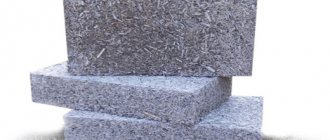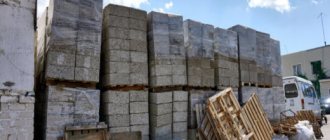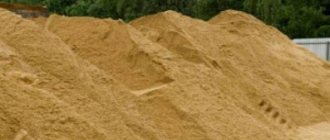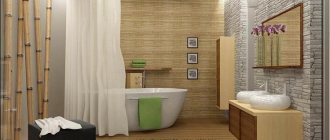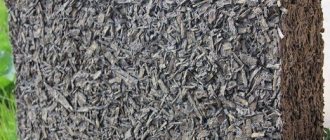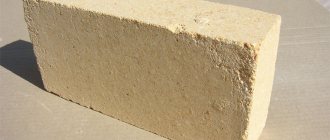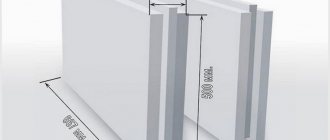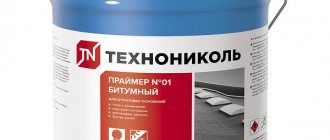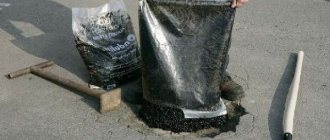What are ceramic blocks?
Ceramic brick has been used in construction since ancient times and has not lost its popularity to this day. Clay, which is the main component in the production of ceramics, is considered one of the best building materials, because it is completely environmentally friendly and allows you to create products of various shapes and configurations.
Porous ceramic blocks are a more advanced version of ordinary brick. Such blocks, due to the presence of many internal cavities, have an excellent ability to retain heat. Porosity also reduces the mass of the material, which makes it possible to create fairly large parts.
Ceramic blocks also differ from bricks in that during their production a certain amount of sawdust is added to the clay.
After the finished but raw product is fired in the oven, the sawdust will burn out, forming voids inside the material. Pores in such blocks are also created using a vacuum press.
The end result is a durable and hard, but fairly light and warm building material.
What is a porous ceramic block?
Often a ceramic block with pores inside is called a large-format stone or porous or warm ceramics. This is a more high-tech replacement for hollow red brick. In terms of raw materials and many operational parameters, they are similar. But the ceramic block is at least 2.1 times larger than its analogue.
Ceramic block options
The shape of this building material is complex with a tongue-and-groove system on two long sides. Such a comb allows you to minimize the number of through seams in the masonry, which reduces the overall thermal conductivity coefficient of the wall. Compared to buildings built from ordinary brick, houses made from ceramic blocks are obviously warmer.
Production of ceramic blocks
When producing this building material, the clay mass is first molded with porosizers added inside, and then dried in a dryer and fired in a kiln. The entire production cycle of such artificial stone takes several days. This is not a handicraft, but a factory product. By purchasing this material, the owner of the future home can be sure that the product is of high quality and complies with GOST. This is strictly monitored in factories.
A mixture of clay and sawdust to further obtain voids
The following can act as a porosizer:
- Straw;
- Wood sawdust;
- Husks of seeds or rice;
- Peat, etc.
All these are combustible materials of natural origin. Their main task is to burn out to the ground when firing ceramic stone in a kiln. After them, only numerous voids remain inside, which give them high thermal characteristics.
Technical characteristics of ceramic blocks
The dimensions and properties of ceramic blocks are described in GOST 530-2012 “Ceramic brick and stone”. The standard specifies 14 standard sizes of ceramic stone, which allows you to lay a wall with a thickness of 250, 380 or 510 mm. The most common standard sizes (LxWxH):
- 250x120x140 mm, 2.1NF (that is, one stone replaces 2.1 standard bricks measuring 250x120x65 mm);
- 380x250x219 mm, 10.7NF;
- 510x250x219 mm, 14.3NF.
Maximum deviations from the nominal dimensions should not exceed ±10 mm in length, ±5 mm in width and ±4 mm in thickness.
The thickness of the outer walls must be at least 8 mm.
Based on average density and standard (not measured) thermal efficiency, ceramic blocks are classified as follows:
| Average density, kg/m³ | Product medium density class | Thermal characteristics group | Thermal conductivity coefficient of masonry in a dry state, W/(m °C) |
| Up to 700 | 0,7 | High efficiency | Up to 0.20 |
| 710-800 | 0,8 | High efficiency | Up to 0.20 |
| 810-1000 | 1,0 | Increased efficiency | 0,20 — 0,24 |
| 1010-1200 | 1,2 | Effective | 0,24 — 0,36 |
In terms of strength, ceramic stone must correspond to grades from M25 to M175; in some cases, M200 or more is found.
Water absorption of products is not limited, but is usually 10-15%.
Frost resistance must be at least 25 freeze-thaw cycles.
The manufacturing technology makes it possible to provide the ceramic block with low thermal conductivity (the best samples have from 0.08 to 0.18 W/m*C). In combination with the large overall dimensions of the ceramic block, this makes it possible to design the building wall as a single-layer structure with a thickness of 25, 38 or 51 cm (1, 1.5 and 2 bricks) without the use of insulation according to modern Russian SNIP standards, the reduction of which relative to world standards was lobbied for Russian builders and block manufacturers themselves. The high strength of the ceramic block (M100-M125) allows its use in the construction of multi-story buildings, and the relatively low volumetric weight (600-800 kg/m3) allows reducing the load on the foundation, thereby reducing its cost. A distinctive feature of warm ceramics is the groove system - a ridge that minimizes the number of cold bridges through the vertical joints of the masonry, while reducing the cost of mortar.
A ceramic block is a building stone of complex shape, created artificially. Thanks to its size, ceramic block has become a serious competitor to ordinary wall bricks; the difference of 10-15 times is a serious confirmation of this. Ceramic blocks are also called differently: ceramic stone, warm ceramics, porous ceramics, large-format stone, but this does not change their properties.
Making ceramic blocks
Most of the ceramic blocks that can be bought in Russia today are imported from European countries. This means not only excellent quality of the material, but also compliance with all technical standards during manufacturing, as well as concern for the environment.
- Clay mining. First of all, the quality of raw materials is assessed; this work is performed by experienced geologists. The clay is then mined and laid out in layers in warehouses. It lies in this form for about a year; such “aging” allows you to achieve the correct consistency of the material.
- Clay processing. In the second stage, the clay is delivered to the plant from the warehouse and placed in the distribution machine. Water, sand, sawdust are added to it and mixed in a mixer into a homogeneous mass. Then this mass enters the grinding machine, where the machine separates equal small granules. After which they are sent on a conveyor belt to an extrusion press.
- Molding. At this stage, the clay mass is transformed into a block using a press, which pushes it under pressure through a special matrix. The resulting blanks are cut into individual bricks. From one matrix (depending on the machine), up to 10 million blocks can be made. The resulting ceramic blocks are placed on pallets and sent to the dryer.
- Drying. The drying process lasts up to 36 hours for thin blocks and up to 45 hours for thicker ones. The moisture content is reduced from 26% to 2%. Next, the blocks are prepared for the next stage - firing, they are placed on fireproof pallets and sent to the kiln.
- Burning. They are in the oven for 6 to 36 hours. Natural gas or coal are usually used for heating. The temperature in the oven is at least 900 °C. It is at this stage that the clay mass gains structural strength, as well as its main feature - the porosity of the material.
- Grinding. More expensive types of bricks, such as those used for cladding, are sanded.
- Package. After the ceramic blocks are removed from the kiln trolleys and polished, they are packaged and prepared for shipment.
Production technology of porous ceramic blocks
The process of producing large-format blocks is similar to the production of ceramic bricks. The following key stages are distinguished: kneading and shaping the product, drying and final firing.
The base material is clay, to which porosizers are added. During the firing process, the additives burn out, and instead of them, micropores are formed, guaranteeing low thermal conductivity during further operation.
Molding
After thoroughly mixing all the necessary components and obtaining a homogeneous substance, the mixture is placed in a vacuum chamber, from which it is squeezed into a mold and cut into pieces.
Drying
Then the workpiece is sent to a drying room, where it remains for 42 to 72 hours, depending on the properties of the raw materials and the size of the product. The temperature in the drying chamber is not constant and increases as the cycle approaches completion.
Burning
The resulting product is transferred to a furnace, where the firing process takes place at a temperature of about 1000°C for about 50 hours. At the final stage, the porous blocks undergo strict quality control to ensure compliance with the geometric dimensions and structure of the building.
Types of warm ceramics by purpose
Main walls
| Name | Width, mm | Length, mm | Height, mm | Weight, kg | Format |
| Porotherm 25M | 250 | 375 | 219 | 14,8 | 10.7 NF |
| Porotherm 38, 38 Thermo | 380 | 250 | 219 | 14,5 | 10.7 NF |
| Porotherm 44 | 440 | 250 | 219 | 16,5 | 12.35 NF |
| Porotherm 51 | 510 | 250 | 219 | 19,5 | 14.3 NF |
Internal walls (partitions)
| Name | Width | Length | Height | Weight | Format |
| Porotherm 8 | 80 | 500 | 219 | 7,2 | 4.5 NF |
| Porotherm 12 | 120 | 500 | 219 | 10,5 | 6.7 NF |
Recommendations for using blocks of different formats
Each ceramic block has its own purpose. Depending on the configuration and size of the porous brick, its different options should be used to solve certain construction problems.
| Where is it better to use | Dimensions in mm |
| For the construction of external and load-bearing walls | 250x380x219; 380x250x219; 440x250x219; 510x250x219. |
| Laying partitions, filling a monolithic frame | 400x200x219; 120x500x219; 80x500x219. |
| Additional elements for dressing seams, etc. | Depending on the main unit |
It is important to remember that the sides of most ceramic blocks have a tongue-and-groove connection system. The exceptions are:
- Relatively small porous bricks in the 1NF (250x120x65mm) and 1.35NF (250x120x88mm) formats are both extremely rare.
- Ceramic porous stone 2.1NF (250x120x140mm).
- Ceramic block 4.5NF (250x250x140mm) - rare. Today it is produced by the St. Petersburg LSR, as well as the Belarusian RKZ plant.
Application
Ordinary porous stone is an energy-efficient material that is used in the construction of both low-rise houses and buildings, and high-rise buildings, especially if they are built using monolithic frame technology. Double porous stone can be used both for the construction of external and load-bearing walls, and for partitions. Strength (grade M-100 and higher) is sufficient for this with a margin.
For the external decoration of walls built from this material, facing bricks, plaster, ventilated facades and much more can be used - this is a matter of taste and the specifics of each specific project.
Advantages and disadvantages
Both large-format porous stone and its smaller “brother” of 2.1 NF format have their advantages and disadvantages. Thus, large blocks often have slightly better thermal conductivity data. In addition, due to the larger size, it is possible to lay out the wall faster. They also do not have seams on the side walls, due to which you can not only reduce the laying time, but also reduce the consumption of mortar or a special warm masonry mixture-glue.
As for the double block, its main advantage is that most masons are good at working with it, since this size is familiar to them, unlike larger blocks. They can also be used for interior work, especially when laying partitions. A slightly higher coefficient of thermal conductivity, when compared with large ceramic blocks, is not such a big problem, since, in any case, the external walls of buildings are usually additionally lined or insulated. For interior partitions, this parameter is not at all significant.
At the same time, double stone will in most cases be stronger. It is also less prone to splitting when compared to the 11.3NF format blocks above. This to some extent facilitates its transportation and loading and unloading operations, which, given the conditions of our construction sites (sloppy workers, poor access roads, etc.) often becomes quite an important point.
Advantages
The advantages of ceramic blocks are impressive:
- Large format products. In terms of volume, a ceramic block is equivalent to several standard bricks (from 2 to 14 or more). This not only reduces the labor intensity of masonry, but also reduces the number of seams - potential sources of ventilation and “cold bridges”.
Using large blocks (as in this photo), we save both time and solution
Additional advantages are savings in mortar and other consumables used in masonry.
- Optimal shape. Protrusions on the side edges of the products allow them to be joined “into a lock”. Thanks to this, the seams are not straight, but zigzag, which minimizes the risk of blowing.
Locks on the side edges minimize the likelihood of blowing
- Good energy saving. Low thermal conductivity makes it possible to lay fairly thin walls – up to 40 cm. In addition, the use of ceramic blocks as the main building material reduces the cost of additional thermal insulation.
- Combination of low volumetric weight and strength. The structure made of porous ceramics is lightweight, so it does not create increased loads on the foundation. At the same time, to ensure the necessary load-bearing capacity, you do not need to build too thick a wall - this is also a plus.
Walls made of “warm ceramics” are light, durable and well ventilated
- Good vapor permeability. A wall made of this material allows moisture to pass through well. This ensures the maintenance of a normal microclimate in the room - the natural ventilation of the wall is not disturbed.
Are there any disadvantages to porous ceramic blocks?
Photo: website wienerberger.ru
The downside of a large format and a large number of pores inside is fragility. It is imperative to think through the transportation and construction process taking this feature into account.
Professionals recommend planning the layout of the wall in advance, before installation, to avoid cutting blocks and loss of strength characteristics. A properly laid wall made of “warm ceramics” becomes strong and reliable.
Low frost resistance. Large voids allow ceramic blocks to boast a frost resistance of about 50 cycles. This means that a facade wall made of “warm ceramics” is necessarily protected from the outside with a facing material: clinker tiles, ceramic bricks, hand-molded bricks, natural or decorative stone, a ventilated facade or a plaster facade system . A properly organized wall structure will serve for many years and “work” only for the benefit of the house.
Flaws
Large-format ceramic blocks are not without flaws:
- Fragility of the internal structure. Compressive strength does not negate the fact that relatively thin partitions can break under mechanical stress. This fact must be taken into account during loading operations.
Cracks are clearly visible in the photograph - most often they appear due to improper loading
It is worth carefully inspecting several products from the batch before purchasing to identify the shortcomings of the ceramic blocks.
- Significant moisture capacity. The porous structure makes the material vulnerable to moisture. Because of this, it is necessary to spend effort and money on additional waterproofing of the masonry (from below and from the outside). In addition, the material must be protected from precipitation during open storage.
Waterproofing is absolutely necessary: efflorescence appears already at the masonry stage, and it will only get worse
- Relatively low frost resistance. The “legs” of this problem grow from the same place: the more moisture that can accumulate in the material, the more problems arise when it freezes. Regardless, effective waterproofing helps.
- Discrepancy between the declared strength and actual performance . This, in fact, is not a problem with the ceramic block itself, but with unscrupulous manufacturers. You can reduce the risk in two ways: either buy material from trusted suppliers, or take it with a strength margin of approximately 25% of the calculated value.
Finally, you need to analyze such an important parameter as price. There are two aspects to this:
Ceramic block is more expensive, but its large size and good thermal insulation add up to savings compared to other materials
- On the one hand, ceramic blocks are more expensive than many building materials, so the costs of constructing load-bearing structures will be higher.
- On the other hand, the thermal characteristics of ceramic products and their large sizes make it possible to significantly save on mortar and insulation. In addition, the large size of the blocks speeds up the laying process. So in the end, instead of an increase in price, there are quite noticeable savings.
Positive characteristics
Porous blocks have advantages over brick. Among the advantages, it is worth noting the porous structure, which allows you to obtain higher qualities of noise insulation and heat conservation with less weight. Among other things, such products are large in size, which allows the construction of houses to be completed in a shorter time. They are durable, have high strength and guarantee less solution consumption. Just 20 years ago, consumers knew 2 types of ceramic blocks; today there are several dozen of them. Products differ in size, format, purpose, performance and other properties. The most popular porous blocks are marked as follows: 2.1 NF or 14.5 NF. The designation indicates how many times the product is larger than modern brick. They are used for commercial and residential construction; they are used to form parapets, load-bearing walls, partitions and fences. A building constructed from this material will have a microclimate inside that is suitable for humans, providing good sound insulation and retaining heat.
How to make a thermal calculation
Thermal engineering calculation is necessary to determine the thickness of the building wall and the thickness of the insulation for the comfortable existence of people. It is carried out in accordance with SNiP 23-02-2003 “Thermal protection of a building”.
1. Determine the type of building and select appropriate materials. This can be a residential building, a public building, heated periodically or seasonally. Thanks to this, you can save building materials and prevent the room from getting wet, wet and mold.
2. Determine the type of enclosing structure, type of uniformity, location relative to the external environment. Provide a diagram of the structure's fencing indicating all structural elements and materials with their characteristics.
3. Select the construction area and its climatic conditions. Based on this, you will decide on the duration of the heating period, the average outdoor temperature, and the humidity zone of construction.
4. Determine the characteristics of building materials and structures. These are density, specific heat capacity, vapor permeability coefficient, specific heat capacity, heat absorption coefficient, thermal resistance of air layers.
5. Select a design solution for enclosing structures. They must have the necessary strength, rigidity, stability, and durability. In multi-layer building structures, on the warm side, place layers of greater thermal conductivity and greater resistance to vapor permeation than the outer layers.
Features of laying walls made of warm ceramics: how to avoid mistakes
Everyone wants their own home to be reliable, comfortable and durable. Therefore, when choosing this or that building material, most owners are guided by operating parameters. But in order to achieve such an important goal as quality housing, it is necessary to take into account not only the performance qualities of the material, but also the manufacturability of its use. The characteristics of the future home largely depend on the masonry technology. Walls made of thermal blocks comply with the parameters declared by the manufacturer only if the masonry instructions are followed. The main construction errors include the following construction techniques:
- Attracting experienced
builders
. Manufacturers issue instructions for their products that explain the installation technology. It provides the main options for technical solutions (combination with the base and ceilings, erection of a wall structure, laying corners). To work with heat blocks, qualified masons with relevant work experience and familiar with this technology and instructions should be invited.
- Using traditional cement mortar
. The blocks are laid not only using the proprietary warm mixture recommended by the manufacturer; The use of cement mortar is not excluded. Such a replacement is considered by some to be unequal, since cement joints have higher thermal conductivity and can significantly reduce the thermal efficiency of the building.
- Filling vertical joints
. According to the technology, joints up to 5 mm wide are not filled with mortar. But, if the width exceeds the standard value, or there is a defect in the block (a ridge is missing), filling is required.
- Tool replacement
. To cut ceramic blocks, you need a specialized cutting tool. The result of using a handy tool will be an uneven edge, which can only be compensated by increasing the thickness of the masonry mortar and the thermal conductivity of this section of the wall.
Video description
About cutting a ceramic block with an alligator saw in the following video:
- Combination of materials
. There are often cases when, for some reason, builders use a combination of thermal blocks and bricks in the construction of external walls. Brick fragments of masonry have a thermal conductivity that is 4-5 times higher than that of porous ceramics. A house with combined walls will require high heating costs; you will have to forget about saving.
- Unjustified budget increase
. For laying internal walls, it is customary to use blocks up to 250 mm thick. Instead, they often choose larger material (380 mm), which does not improve the quality of housing, but leads to increased costs.
- Neglect of storage rules
. If construction work is suspended, unfinished wall structures and unused blocks must be protected from atmospheric moisture.
Advantages of ceramic stone
Thanks to modern production technology and the peculiarities of its structure, porous ceramic stone has a number of significant advantages:
- Low thermal conductivity
- due to the many air-filled voids, the blocks retain heat well and prevent the appearance of cold bridges. - Strength
– after firing, there is no moisture in the ceramics, so the products have higher strength characteristics in comparison with aerated blocks or foam concrete. - Vapor permeability
– stone walls have the ability to regulate the level of humidity, which ensures a comfortable microclimate in the house. - Resistance to external influences
- the material is not susceptible to chemicals, mold, or harmful microorganisms. - Environmentally friendly
- clay and natural additives are used to make stone, so the blocks do not pose a health hazard. - Light weight
- the walls are easy to erect and do not place excessive load on the foundation. - Speed of masonry
- due to the overall dimensions, the time for construction of buildings made of porous stone is reduced by approximately 3 times (compared to conventional brick). - Savings
- installation work requires a small number of products, and the volume of solution used is reduced by approximately 30%.

